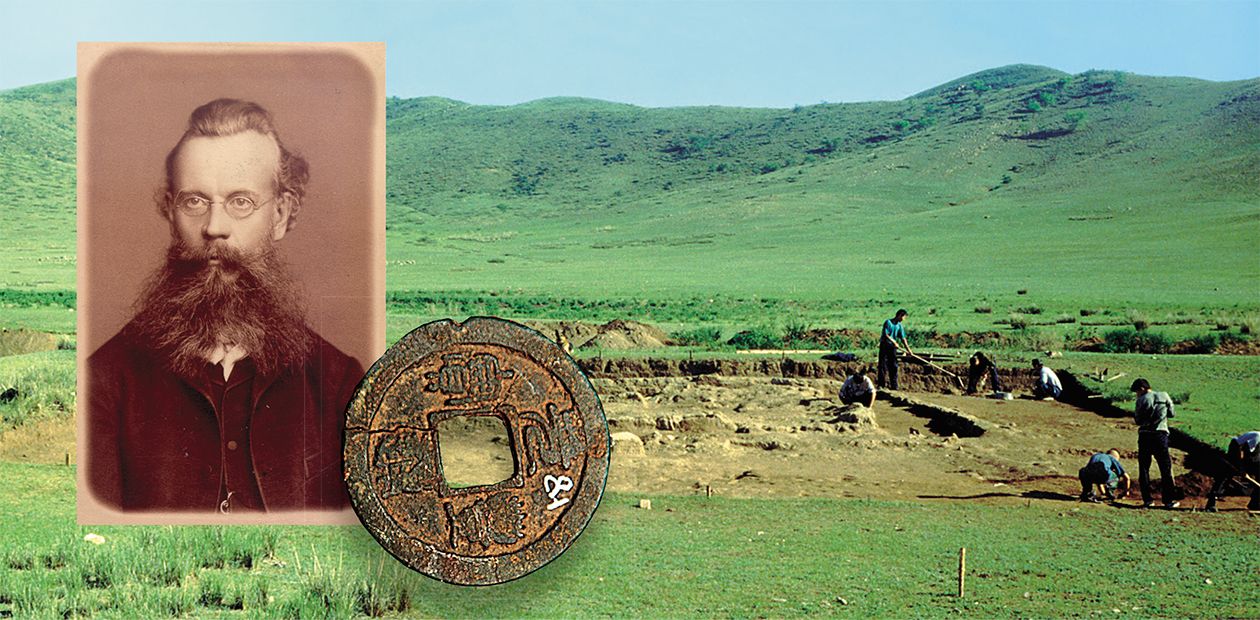Cities Built by... Nomads
A traveler exploring the endless Mongol steppes occasionally sets his eye not only on fanciful weathered rocks, fields of rounded boulders bringing to mind glacier activity, stone statues and mounds… Sometimes he can see ruins of towers and high walls or almost invisible hillocks hiding remains of ancient constructions. Local inhabitants know next to nothing about the residents of these ancient settlements. Our memory has not preserved neither the names of the builders nor of the peoples who used to inhabit these derelict ruins…
Medieval towns in Central Asia were first discovered in the early 19th century by the Russian connoisseurs of the relics of the past G. I. Spasskiy, A. K. Kuznetsov and V. Parshin, who described the ruins of the site of an ancient settlement on the river Khirkhira in Cis-Argun area and “the Konduiski town” in East Transbaikal area. Explorers of South Siberia A. V. Adrianov and, after him, S. A. Teploukhov found, on Tuva’s territory, ruins of towns that were subsequently dated from the time of the Mongol Empire.
Nevertheless, proper scholarly discovery of the ancient towns of Central Asian nomads took place at the end of the 19th century, when the expedition of the East-Siberian Department of the Russian Geographic Society headed by N. M. Yadrintsev came to Mongolia. In the valley of the Orkhon River in northern Mongolia, the explorers found, apart from stone steles with inscriptions and vast burial grounds, ruins of the ancient Uigurs city of Khara-Balgasun and of the Mongol capital Kharakhorum.
In 1890 the expedition headed by the well-known archaeologist specializing in Turk studies V. V. Radlov, later referred to as the Orkhon expedition, went to this region and discovered numerous archaeological artefacts which later became a true sensation in the academic circles. The findings made by this expedition included ruins of cities buried in the earth.
Search for Central Asian ancient cities continued in the following century. Thus, in 1907 P. K. Kozlov’s expedition made a discovery of Khara-Khoto *, a large city of the Tangut state of Xi Xia, where thousands of manuscripts written in many languages were found. The most valuable contribution to these explorations, however, was made by the Soviet-Mongolian expedition headed by Corresponding Member of the USSR Academy of Sciences S. V. Kiselev in the 40s and 50s of the last century. In Mongolia, Transbaikal region and Tuva, the scholars found and examined ruins of dozens of cities dated from various epochs. The expedition’s most impressive achievement was excavations of the capital of the Mongol state, the city of Kharakhorum.
Following the nomad empires
Archaeological excavations produced tremendous results which evidenced that the settled way of life was an ancient and well-established tradition of Central Asian nomad communities. And yet, archaeological data alone cannot explain the reasons why settled life took root with the nomads or what made them build monumental palaces and solid defense constructions. To gain an insight into this problem, we have to turn to written sources that contain information on the history of nomadic peoples.
European missionaries were the first to study the history of Central Asian peoples. They only dealt with ancient Chinese manuscripts and did not have the faintest idea of the level of material culture of the nomads or of their skills to erect buildings and fortifications. These manuscripts, however, were a source of valuable data about the peoples who inhabited Central Asia in the ancient times. Russian history got access to the data contained in the ancient Chinese documents thanks to N. Ya. Beechurin (Father Iakinph, head of the Orthodox mission in Beijing in the 18th century).
Judging by this written evidence, chiefs of the nomads of Central Asia, virtually throughout its history, fought violently for power. Glory and power were won in wars, during which blocks of nomadic tribes formed and fell apart. Under favorable circumstances, some ambitious leaders could unite under their banners practically the entire population of the Mongol steppes, which gave rise to nomad empires — a big challenge for scholars — that could affect the course of the world history. The majority of modern explorers believe that such a level was achieved by the political blocks of Khunnu, Syanbi, Zhuzhan, Turks, Uigurs, Kidan and, of course, Mongols.
Encouraging the formation of such steppe states was an elaborate tangle of objective and subjective factors and circumstances, the true content of which we can only conjecture. A visible consequence of the complicated processes of formation of the nomad empires was the construction of cities.
The capital of Kharakhorum
The first brief evidence on Mongol cities can be found in medieval travel notes left by educated people who made a journey to various uluses of the Mongol empire. The famous Venetian Marco Polo visited the Mongol empire during the reign of Khubilai, Chinggis Khan’s grandson, when the political and economic center of the empire had shifted from Mongolia to China. In his book he gives a short description of Kharakhorum, probably based on the stories told to him by his father and uncle.
The sources testify that in 1235 the great Khan erected a wall around the city and constructed the Van-an-gun palace. To make the capital look properly, a decree was issued to the effect that “each of the brothers, sons and other tsareviches attached to him build a magnificent house in the vicinity of the palace. Everybody obeyed the decree. When those houses were completed and adjourned one another, there proved to be a great multitude of them.” (Ancient Mongol Cities, 1965, p. 136).
The most complete data about the capital can be found in the work The Journey of William of Rubrouk to the Eastern Parts by Guillaume de Rubrouck, who lived in Mongolia in 1253—1255 as an envoy of the French King Louis. “It is known about the city of Kharakhorum <…> that, with the exception of the palace, it is even inferior to the suburb of St. Dionysius, and that the St. Dionysius monastery is ten times more expensive than the palace. There are two quarters: one for the Saracens, where bazaars are held and many merchants gather because the court is always nearby and ambassadors are abundant; and the other quarter is that of the Katays, who are all craftsmen. Outside these quarters there are big palaces belonging to the court secretaries. Twelve joss-houses of different peoples are located here, two mosques in which Mohammed’s law is proclaimed, and a Christian church at the outskirts of the city. The city is surrounded with a wall made of clay and has four gates. At the eastern gate they sell wheat and other grain, which, however, is not often brought here; at the western gate they sell lambs and goats; at the southern gate they sell oxen and carts; and at the northern gate they sell horses.” (Rubrouck, 1997, p. 161).
Even though this description is complete and detailed, it is not satisfactory for researchers to rely on the only written evidence of a city that no longer exists. So far we can make conclusions about the architecture, construction techniques and materials used for erecting the buildings of the Mongol capital only basing on the artefacts excavated by the Kiselev expedition. Members of the expedition also found trace of a variety of craft industries clearly oriented toward commerce. The need of the population in craft goods was also met thanks to the goods imported, mainly, from China. These data confirm the information found in the written documents about the Chinese and Moslem merchants who controlled trade inside the Mongol state and also about the crop-growing occupation pursued by a part of its population.
Moslem travelers of the 13th—14th centuries (the best known among them was probably Ibn Battutta) mostly left notes about the cities situated within the territories of Iran, Middle Asia and the Golden Horde.
Mongol bureaucracy and the cities
Intensive construction of cities in the steppe areas of Eurasia became possible only when the economic situation of the Mongol state reached a relatively high level. Cities could be built only after important administrative and economic reforms had been carried out, which helped the ruling circles to concentrate in their hands huge material values and human resources.
It must have been impossible to govern the country having a vast territory, a highly intricate ethnic and social demography and varying economic potential without appropriate administrative personnel. A high number of officials of various ranks were concentrated at the Great Khan’s headquarters, at chiniguizids (owners of uluses) and at the courts of local rulers of principalities.
An urgent need thus appeared to set up stationary points from which the empire could be governed. Actually, first settlements of this kind date back to the time when Temüjin became the Great Khan. And yet, conversion of these settlements into cities became possible only in the early 30s of the 13th century, when Chinggis Khan’s son and successor Ugedey carried out economic reforms and exerted strict control over the population of the countries conquered. In all probability, it was for the economic and political reasons that cities sprang up and grew in the steppe, where before the Mongol invasion there had been no urban culture, like, for example, in southern Russian or Kazakh steppes.
After the capital was completed, cities began to be built all over Central Asia. All of them demonstrate a remarkable similarity in architectural designs and construction materials, which implies that urban construction was under the state’s control. At least, a special department must have been set up to supervise compliance with the construction rules. Testifying to this fact are results of excavations of various archaeological monuments, such as the building of the Mongol epoch discovered in Buryatia in the vicinity of the town of Narsatuy. Remains of the construction materials found there coincide in shape, size and manufacture technologies with the tiles, bricks and terracotta ornaments of the roof excavated at the sites of other Mongol cities.
Today, we know over 30 cities dated from the time of the Mongol Empire, which are situated in modern Mongolia, Transbaikal area, Tuva and China. And yet, we are not confident whether traditions of urban culture, which contradict so much our ideas about the nomadic way of life, were conceived in the womb of the Mongol society or adopted from other peoples such as Hunnu, Uigurs and Kidans… Large-scale excavations involving specialists of various profiles and interests are a must — most ancient cities are still waiting for their explorers.
*You can read about the Dead City of Khara-Khoto in SCIENCE First Hand, № 6 (11) 2006.










